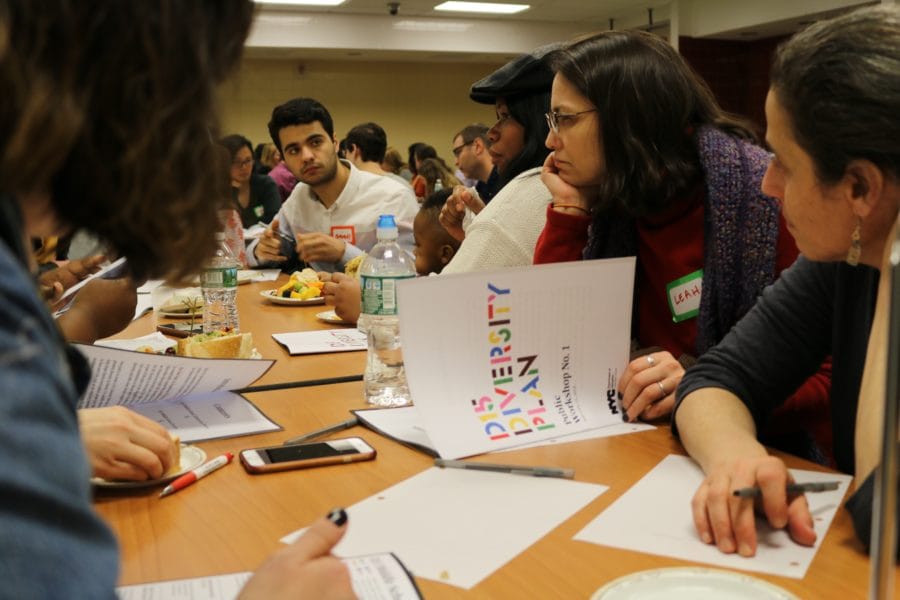District 15 middle schools may eliminate academic “screening” in effort to integrate


By Christina Veiga, Chalkbeat
PARK SLOPE – In a Brooklyn district where middle schools are sharply divided by race and class, a radical recommendation to spur integration has emerged: eliminating selective admissions all together.
After a monthslong public process, the recommendation was unveiled Wednesday as part of a sweeping set of reforms aimed at integrating middle schools in District 15. The district spans Brownstone neighborhoods such as Carroll Gardens and Park Slope, as well as immigrant enclaves including Red Hook and Sunset Park.
The proposal to eliminate “screens” adds fuel to a growing debate over whether public schools should be allowed to sort students based on their academic achievement — a bedrock tenet of how New York City’s education system currently works. Doing away with selective admissions policies seemed unthinkable just a few months ago, but within weeks of becoming schools chancellor, Richard Carranza questioned the practice that some District 15 parents now want to roll-back.
“You see that all these criteria have a significant disparate impact on the black and Latino students, and on the low income students,” Miriam Nunberg, a District 15 parent who was involved in the integration effort.
The recommendations for District 15 were made by a group of parents, educators, and activists who were convened by a planning group hired by the education department to seek community input. They are almost guaranteed to be controversial, as a different effort to integrate middle schools on the Upper West Side has been.
“I’d be lying if I didn’t say that I have a little anxiety,” said Councilman Brad Lander, who represents Park Slope and other Brooklyn neighborhoods, and has been an outspoken integration advocate. “I feel so enthusiastic about this, and so hopeful and grateful about where we can go, but we also have to make room for some conversations that will be challenging.”
But advocates probably could not have picked a better time to act. Carranza has proven far more willing to take on segregation than his predecessor. And the mayor has recently made his most aggressive integration push yet, proposing to overhaul admissions at the city’s elite specialized high schools in an effort to admit more black and Hispanic students.
Along with the elimination of screens, the district is also proposing to give some students admissions preferences, similar to integration plans that have been approved in other districts. In an aim to enroll a similar share of students who are poor, learning English, or live in temporary housing, every middle school would give priority to those students for about 52 percent of seats. That percentage is in line with the district average.
The district is also recommending a lengthy list of actions to make schools open and inclusive of everyone, and to make sure that schools have all the resources they need.
“The District 15 diversity plan was not about moving bodies around,” said Neal Zephyrin, a member of the local Community Education Council. “You can have diverse schools, but the classrooms in that school can still be segregated. Lunchrooms can still be segregated. Curriculum and content can still not be inclusive.”
With the release of the recommendations, the city hopes to collect feedback and develop a final proposal to present to the education department in July. It will be up to the department to accept and implement any admissions changes, and no firm deadline has been given for a decision.
About a quarter of middle schools and a third of high schools across the city “screen” their students based on factors such as test scores, report card grades, and attendance. Critics say that exacerbates segregation since students of color are more likely to struggle in school.
In District 15, students apply to middle schools. Of the district’s 11 middle schools, only one doesn’t screen its applicants. While middle school enrollment there is about 55 percent black and Hispanic, about 81 percent of white students cluster in just three schools. The removal of screens would also apply to New Voices School of Academic and Creative Arts, which currently requires an audition.
Unlike a fiery meeting this spring on the Upper West Side, though, the response at Wednesday night’s meeting was an extended round of applause once the recommendations were presented. Antelma Valdez, who has two children in District 15 schools, said she supports the removal of screens.
“It provides opportunity to all students, including those without resources who are limited,” she said. “We want more equity… because we know they have talent.”
But doing away with selective admissions will likely be met with fierce opposition. Middle-class parents have been able to navigate a complicated admissions process and ensure their children win spots into the most sought-after middle schools, which pave a reliable path to the city’s elite high schools.
Still, the process to get into a desirable middle school is often so stressful that advocates are hopeful they can win over anxious parents. Students face competition from hundreds of other applicants for the most selective schools. Parents often pay tutors to help students score well on tests that are used in admissions decisions, and for consultants to help them navigate an often opaque system of open houses, deadlines, and audition dates.
“Everybody hates it. The kids are stressed out,” said Amy Brill, the mother of a rising fifth-grader in the district.




